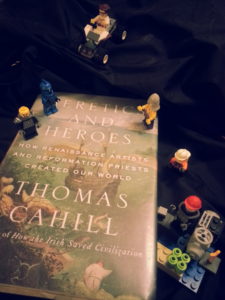 A look back over history shows that there are certain periods in time during which innovation and cultural change dramatically increases. The book Heretics and Heroes: How Renaissance Artists and Reformation Priests Created Our World is the sixth volume of Thomas Cahill’s The Hinges of History series in which the events of these critical periods of western history are documented and retold. Heretics and Heroes focuses on the cultural and religious upheaval in Europe during the sixteenth century.
A look back over history shows that there are certain periods in time during which innovation and cultural change dramatically increases. The book Heretics and Heroes: How Renaissance Artists and Reformation Priests Created Our World is the sixth volume of Thomas Cahill’s The Hinges of History series in which the events of these critical periods of western history are documented and retold. Heretics and Heroes focuses on the cultural and religious upheaval in Europe during the sixteenth century.
Divided into seven sections with a prelude, introduction, intermission, and postlude, the book highlights various innovative ideas and concepts that arose during the Italian Renaissance and the Protestant Reformation. Woven throughout the text is a nod towards the “centuries-long game of philosophical tennis”[1] being played out behind the events themselves. This game, as Cahill outlines in his prelude, is between the Platonic-Augustinian and Aristotelian-Thomistic schools of thought on how reality is perceived. During the time period covered by Heretics and Heroes the Platonic-Augustinian view of reality (i.e. that the “phenomena of our world…leads us to the absolute realities…[of] Beauty, Truth, Justice, Unity…and…Goodness” [2]) becomes the dominate view over and against the Aristotelian-Thomistic view (i.e. that “there is no world of Forms beyond the world we know and see” [3]).
Though it may seem unlikely, the motivation for both the master artists of the Renaissance and the leaders of the Germany Reformation can be found in the newly rediscovered drive to know and understand the absolute realities behind what we see and hear. The artists followed a blend of Platonic philosophy and Medieval Christianity that saw the “human flesh [as] a fine thing” [4]; hence their desire to create humanity at its best. The preachers of the Reformation, on the other hand, used this desire to fuel their pursuit of Truth over and above the realities of church and political power and the weight of tradition. Martin Luther’s statement at the Diet of Worms in 1521 is the clearest example of this desire for Truth as he dismisses the “authority of…popes or council by themselves” in favor of the intangible authority of “Scriptures and…plain reason.”[5]
In unveiling the joint motivation for the Renaissance and Reformation movements, Cahill opened my eyes to a previously unknown subset of European history. As an avid reader and lover of history, I have read multiple books about the Reformation and the events leading up to and following this movement. However none of these books connected the Reformation events to the Renaissance or the rise of Platonic-Augustinian philosophy. Accordingly I am grateful for Cahill’s blending of these movements has it has provided me with yet another part of the “mechanism of our functioning contemporary selves.”[6]
In a very practically manner, I can see myself paying more attention to the art around me and the meaning being conveyed through the art. Prior to reading Cahill’s Heretics and Heroes book I had never paid attention to the deeper cultural and philosophical context and meaning of an art piece. Rather I would just see the picture itself without looking any deeper. Now, however, I am curious as what other secrets are lurking behind the canvases and sculptures of the Renaissance and other time periods.
End Notes
[1] Thomas Cahill. Heretics and Heroes: How Renaissance Artists and Reformation Priests Created Our World (New York: Nan A. Talese, 2013), 7.
[2] Thomas Cahill. Heretics and Heroes, 5.
[3] Thomas Cahill. Heretics and Heroes, 6.
[4] Thomas Cahill. Heretics and Heroes 105.
[5] Thomas Cahill. Heretics and Heroes, 182.
[6] Thomas Cahill. Heretics and Heroes, 305.
